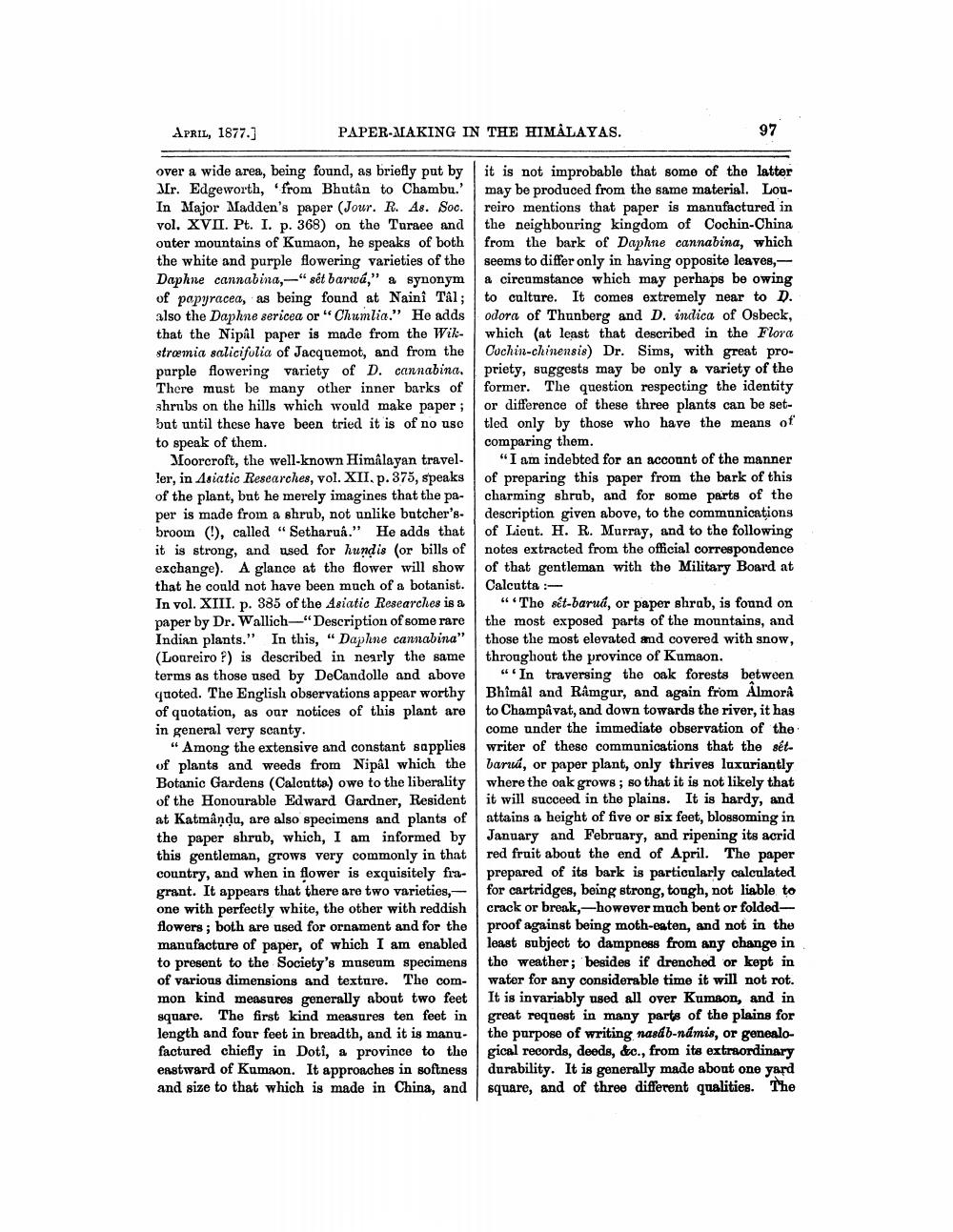________________
PAPER-MAKING IN THE HIMALAYAS.
APRIL, 1877.]
over a wide area, being found, as briefly put by Mr. Edgeworth, from Bhutân to Chambu.' In Major Madden's paper (Jour. R. As. Soc. vol. XVII. Pt. I. p. 368) on the Turaee and outer mountains of Kumaon, he speaks of both the white and purple flowering varieties of the Daphne cannabina,-"sét barwá," a synonym of papyracea, as being found at Nainî Tâl; also the Daphne sericea or "Chumlia." He adds that the Nipâl paper is made from the Wikstræmia salicifolia of Jacquemot, and from the purple flowering variety of D. cannabina. There must be many other inner barks of shrubs on the hills which would make paper; but until these have been tried it is of no use to speak of them.
Moorcroft, the well-known Himalayan traveller, in Asiatic Researches, vol. XII. p. 375, speaks of the plant, but he merely imagines that the paper is made from a shrub, not unlike butcher'sbroom (), called "Setharuâ." He adds that it is strong, and used for hundis (or bills of exchange). A glance at the flower will show that he could not have been much of a botanist. In vol. XIII. p. 385 of the Asiatic Researches is a paper by Dr. Wallich-"Description of some rare Indian plants." In this, "Daphne cannabina" (Loureiro ?) is described in nearly the same terms as those used by DeCandolle and above quoted. The English observations appear worthy of quotation, as our notices of this plant are in general very scanty.
"Among the extensive and constant supplies of plants and weeds from Nipâl which the Botanic Gardens (Calcutta) owe to the liberality of the Honourable Edward Gardner, Resident at Katmandu, are also specimens and plants of the paper shrub, which, I am informed by this gentleman, grows very commonly in that country, and when in flower is exquisitely fragrant. It appears that there are two varieties, one with perfectly white, the other with reddish flowers; both are used for ornament and for the manufacture of paper, of which I am enabled to present to the Society's museum specimens of various dimensions and texture. The common kind measures generally about two feet square. The first kind measures ten feet in length and four feet in breadth, and it is manufactured chiefly in Doti, a province to the eastward of Kumaon. It approaches in softness and size to that which is made in China, and
97
it is not improbable that some of the latter may be produced from the same material. Loureiro mentions that paper is manufactured in the neighbouring kingdom of Cochin-China from the bark of Daphne cannabina, which seems to differ only in having opposite leaves,a circumstance which may perhaps be owing to culture. It comes extremely near to D. odora of Thunberg and D. indica of Osbeck, which (at least that described in the Flora Cochin-chinensis) Dr. Sims, with great propriety, suggests may be only a variety of the former. The question respecting the identity or difference of these three plants can be settled only by those who have the means of comparing them.
"I am indebted for an account of the manner of preparing this paper from the bark of this charming shrub, and for some parts of the description given above, to the communications of Lient. H. R. Murray, and to the following notes extracted from the official correspondence of that gentleman with the Military Board at Calcutta :
"The set-barua, or paper shrub, is found on the most exposed parts of the mountains, and those the most elevated and covered with snow, throughout the province of Kumaon.
"In traversing the oak forests between Bhîmâl and Râmgur, and again from Almora to Champâvat, and down towards the river, it has come under the immediate observation of the writer of these communications that the setbaruú, or paper plant, only thrives luxuriantly where the oak grows; so that it is not likely that it will succeed in the plains. It is hardy, and attains a height of five or six feet, blossoming in January and February, and ripening its acrid red fruit about the end of April. The paper prepared of its bark is particularly calculated for cartridges, being strong, tough, not liable to crack or break,-however much bent or foldedproof against being moth-eaten, and not in the least subject to dampness from any change in the weather; besides if drenched or kept in water for any considerable time it will not rot. It is invariably used all over Kumaon, and in great request in many parts of the plains for the purpose of writing nasáb-námis, or genealogical records, deeds, &c., from its extraordinary durability. It is generally made about one yard square, and of three different qualities. The




